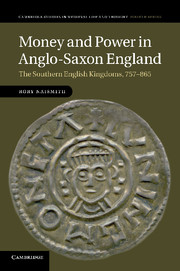Book contents
- Frontmatter
- Contents
- Figures
- Maps
- Tables
- Acknowledgements
- Abbreviations
- Chapter 1 Introduction
- Chapter 2 Money in its political context
- Chapter 3 Looking at coinage: iconography and inscriptions
- Chapter 4 Authority and minting I: the king
- Chapter 5 Authority and minting II: mints, die-cutters and moneyers
- Chapter 6 Value judgements: weight and fineness
- Chapter 7 Production of coinage
- Chapter 8 The circulation of coinage
- Chapter 9 The nature of coin-use in the early Middle Ages
- Chapter 10 Conclusion
- Bibliography
- Index
- References
Chapter 9 - The nature of coin-use in the early Middle Ages
Published online by Cambridge University Press: 07 October 2011
- Frontmatter
- Contents
- Figures
- Maps
- Tables
- Acknowledgements
- Abbreviations
- Chapter 1 Introduction
- Chapter 2 Money in its political context
- Chapter 3 Looking at coinage: iconography and inscriptions
- Chapter 4 Authority and minting I: the king
- Chapter 5 Authority and minting II: mints, die-cutters and moneyers
- Chapter 6 Value judgements: weight and fineness
- Chapter 7 Production of coinage
- Chapter 8 The circulation of coinage
- Chapter 9 The nature of coin-use in the early Middle Ages
- Chapter 10 Conclusion
- Bibliography
- Index
- References
Summary
Even after 1,200 years, voluminous finds have occurred of coins lost in eighth- and ninth-century England, and examination of these in the two previous chapters leads to the central conclusion that they bear witness to vibrant minting and monetary circulation. It will never be possible to pin down exactly how many coins safely changed hands for each one that was lost or concealed in a hoard, though given the relatively high value of even one silver penny at this time, they cannot have been lost lightly.
The finds which metal-detectorists and archaeologists bring to light therefore are very much the tip of the iceberg in terms of evidence for monetary circulation; they are all the more impressive for their quantity and all the more exigent of further investigation. External forces such as warfare and bullion supply had significant effects on coin-use and production, but questions such as who used these coins, how often and for what purposes – the small-scale, grass-roots level of coin-use – are easily side-stepped. Yet they are integral to establishing what part coinage played in the early medieval economy. Refinement is both possible and necessary on the important question of what coin-use meant in the context of the society and economy of the early Middle Ages.
- Type
- Chapter
- Information
- Money and Power in Anglo-Saxon EnglandThe Southern English Kingdoms, 757–865, pp. 252 - 292Publisher: Cambridge University PressPrint publication year: 2011



